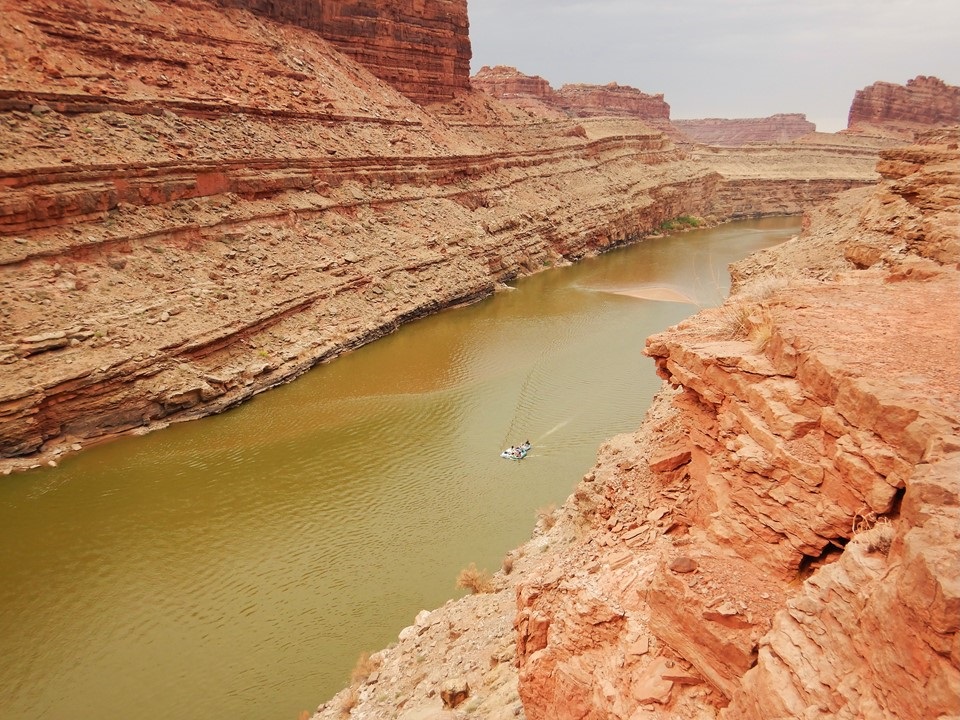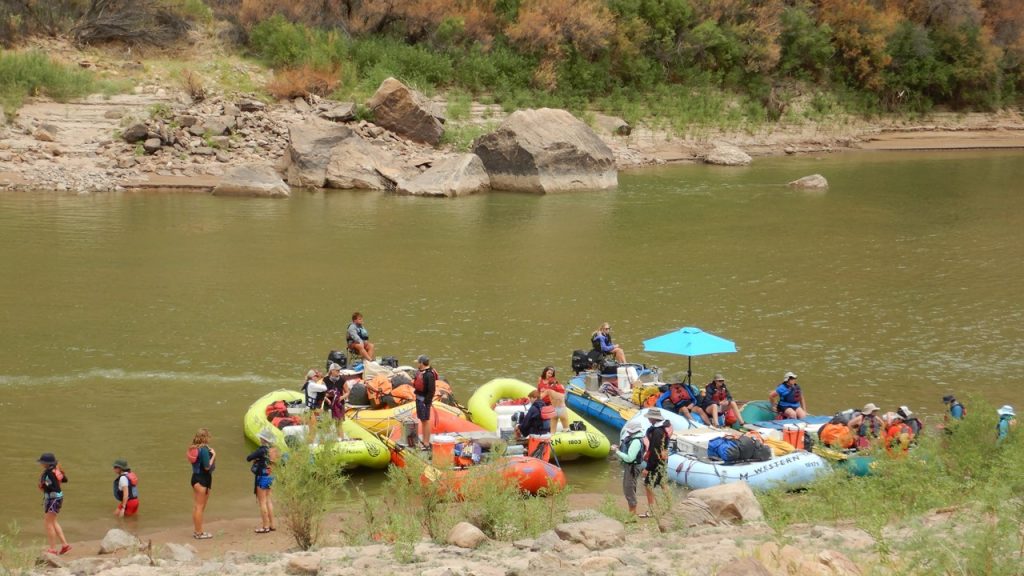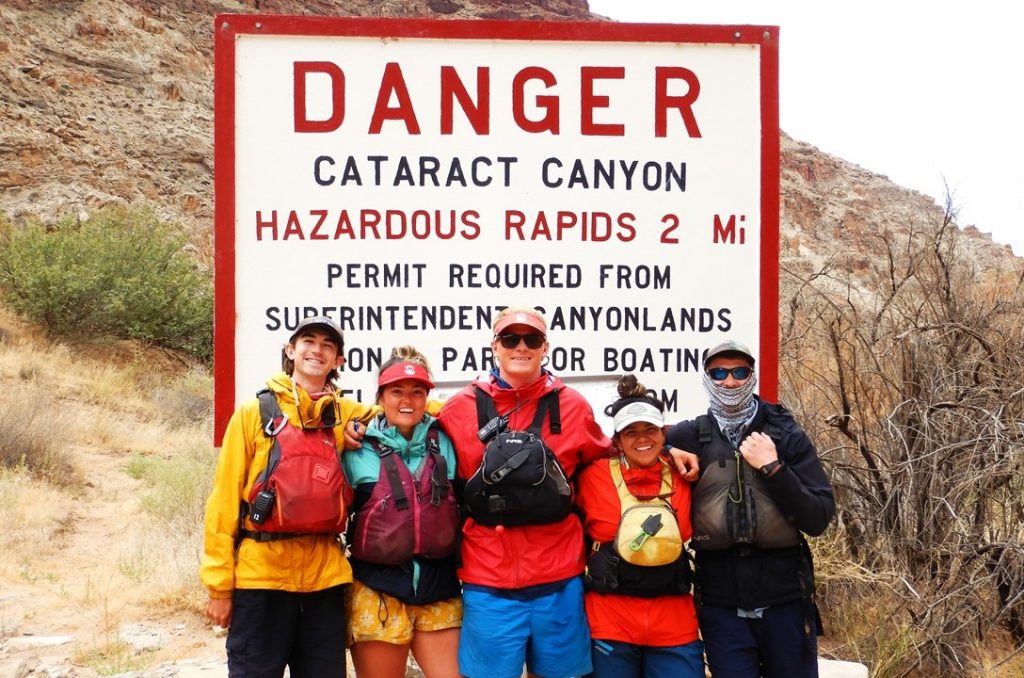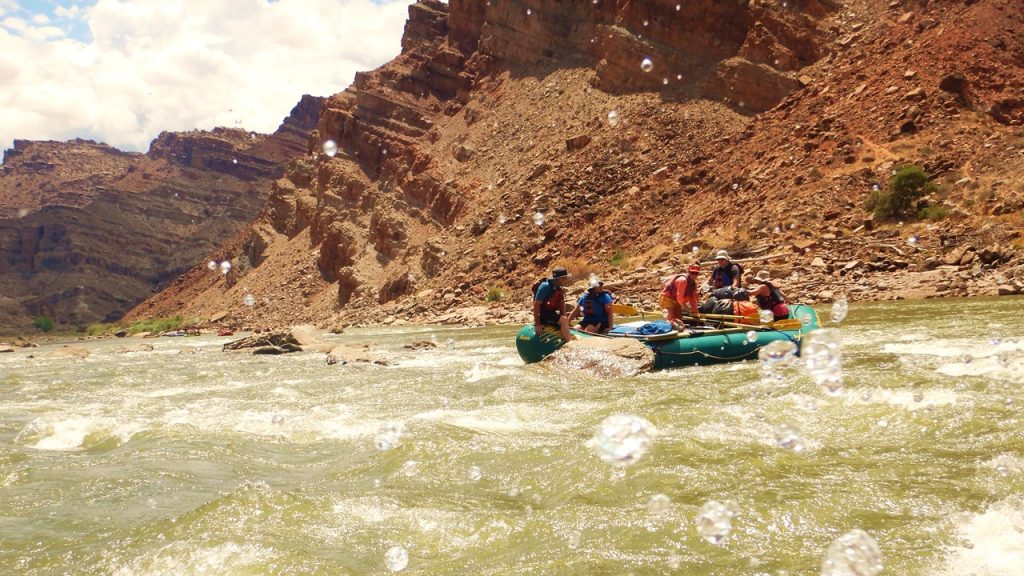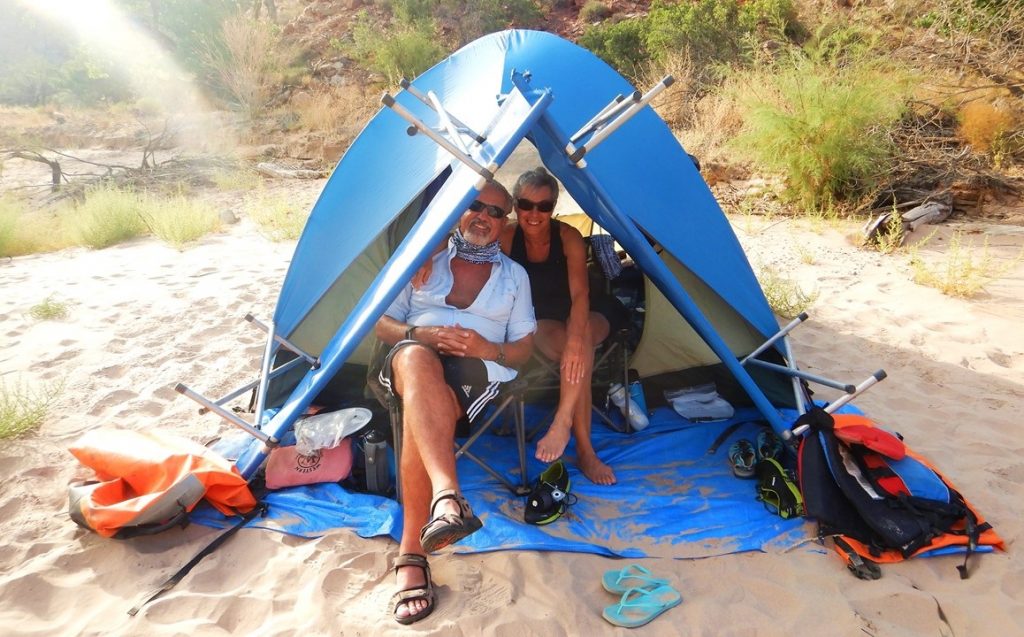July 2020
Exploring & Rafting Cataract Canyon in Utah
Part 3 – Rafting to Before the Big Drops
Rafting the Colorado from Moab to Rapid # 10
The Canyonlands area of southern Utah was one of the last Continental United States areas to be explored. Major John Wesley Powell was the first non-native American to travel and explore the river in 1869. The Colorado River upriver of its confluence with the Green River was originally called “The Grand River” until the State of Colorado forced a name change in 1921. Until rugged inflatable rafts became available after World War II, only a few dozen expeditions had ever managed to navigate this part of the river.
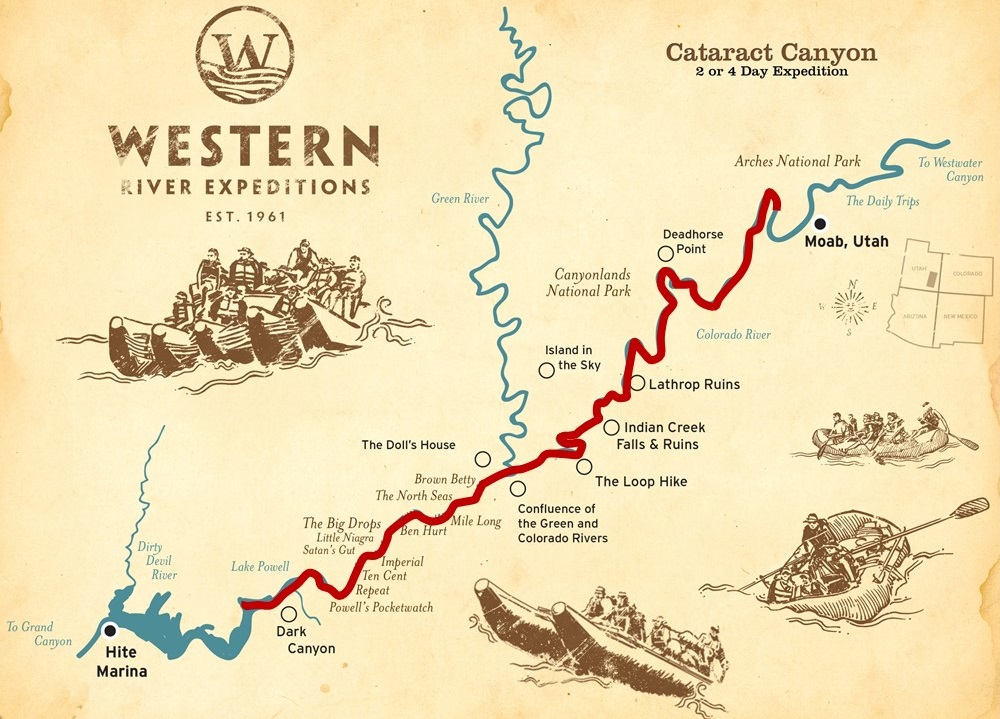
Tuesday morning, we arise, eat breakfast, and check out of our hotel and meet our Trip Group for the short bus ride to the boat ramp. For our expedition, 26 guests with 7 rafts (2 paddle-rafts and 5 oared-rafts), and 7 guides would launch from the boat ramp at Bootlegger Canyon just upriver from Potash and ~54 miles from the confluence with the Green River. Our group was an eclectic mix of families and retirees spanning from 10-70 years old, (one must be at least 10 to take the trip, and 12 if the water is at higher levels). After storing our gear in waterproof bags, we boarded the 5 passenger rafts (2 of the oared rafts were for gear only) and began our adventure down this flatwater part of the trip.

The waters are calm in this part of the river, and so we raft together boats into groups of 3 and 4 and accelerate our trip downriver with a small outboard motor located on each grouping. We enjoy the spectacular scenery and introduce ourselves to each other before taking a “swim-break” in the water after an hour travel. After 16 miles of travel, we are at the closest approach to Dead Horse State Park, and soon after we stop for lunch on a convenient river sandbar. Lunch is cold-cut sandwiches and chips with ever-present water and lemonade to drink. After lunch, we travel again until we get to Lathrop Canyon where we put ashore for a 1/2 -mile hike in the heat to an ancient granary storage site and various petroglyphs. This area of the canyon is visible from the White Rim Overlook in Canyonland National Park. After the hike, we re-board the boats and travel a short distance to our campsite for the night at an area nicknamed “The Corner Pocket” – a large sandbar that has room for our group to pitch tents for the night. Given the hot temperatures, we choose to sleep outside in the open tonight, but we set-up a tent so that our friend, Mary Jane, and Julie have a changing area with a modicum of privacy. That night, we played games while the staff prepare dinner. Appetizer is tortilla chips with fresh guacamole and bean dip, and this is followed by dinner of BBQ chicken with salad and green beans, with chocolate and vanilla cakes for dessert. That night the sky was clear, and the stars shone brightly, but the temperature stayed in the 80’s all night until ~2:30am when a sudden wind-gust toppled a number of unoccupied tents.
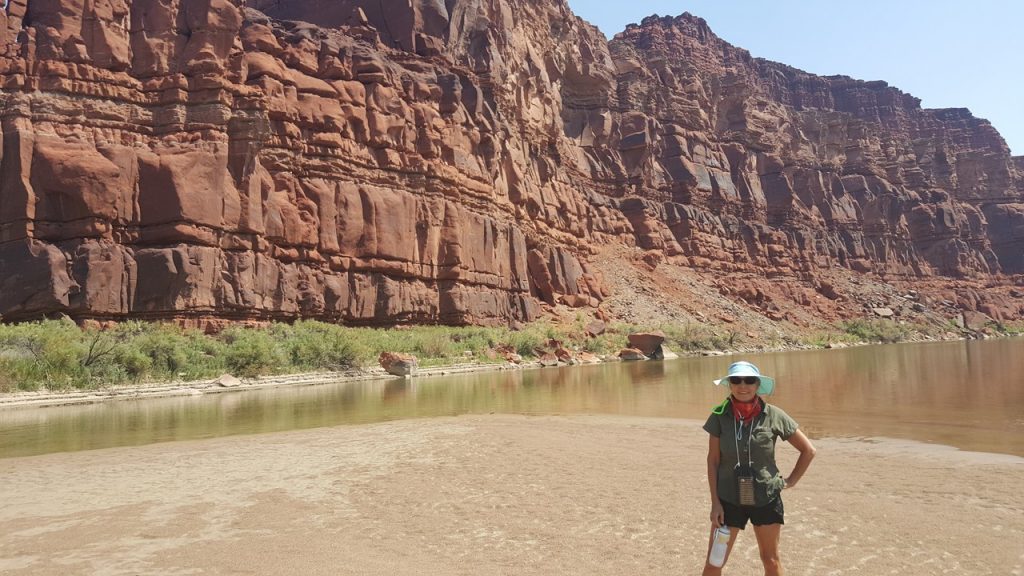
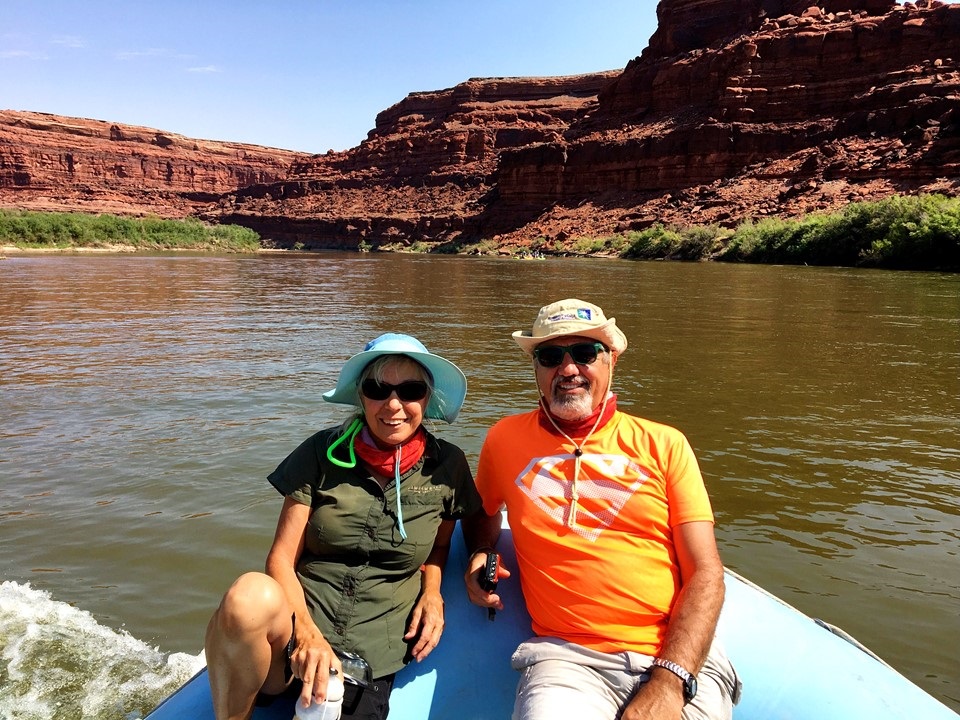

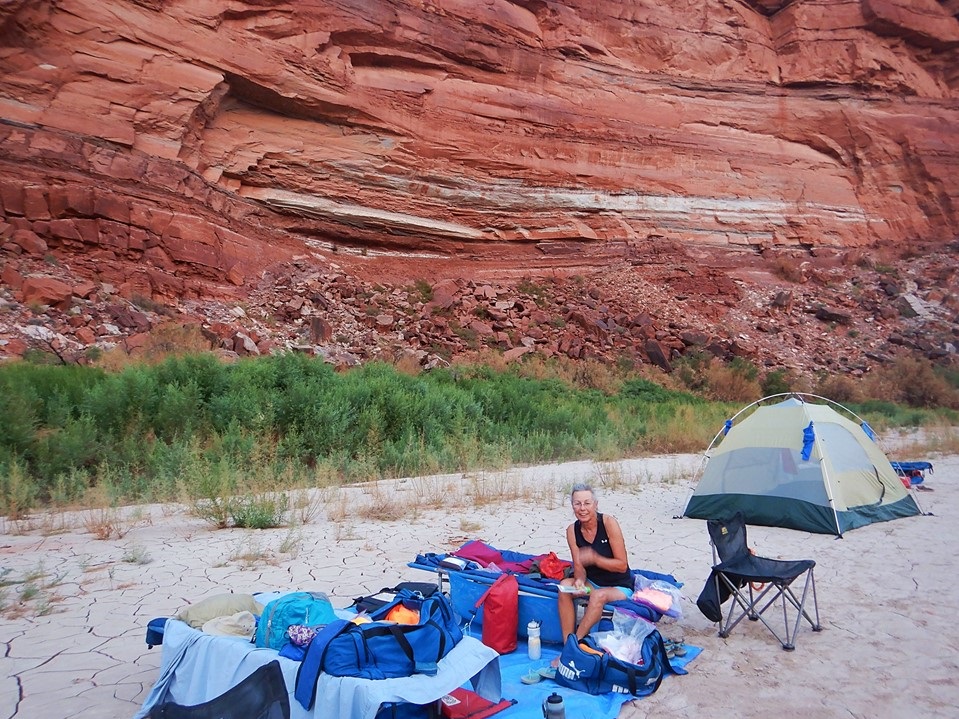
Wednesday morning the (cowboy) coffee was ready by 6:15am and we enjoyed a breakfast of blueberry pancakes, bagels, and turkey sausage before breaking down our camp and repacking our belongings. The National Park Service Rangers showed up in a boat just to check-in and make sure everything was going well, and once we were ready, we set off again downriver. The day is overcast with rain on-and-off, but a welcome relief from the heat of the past 3 days. After a short distance, we came upon a part of the river known as “The Loop” which offered those of us who were interested, the opportunity to disembark the boat and ascend 500’ over the saddle between the double-back bend in the river. While Rocky joined the hikers, Julie rode the rafts the 3-miles around “The Loop” and everyone rejoined on the other side. A short seven miles later and we reached the confluence of the Colorado and Green Rivers, and lifejackets were now required to be worn in the rafts by all participants. A short mile later, we stopped at a “Ranger’s Box” to register our group for campsites for the next two nights, and then, we entered the cataract portion of the river. After passing “The Dollhouse”, (a series of formations on the top of the cliff’s edge in the “Maze” part of the Park, named innocently by Powell’s daughter), we stop at “Lower Red Lake Canyon” for lunch where we saw two deer getting a drink from the river. Lunch was cold-cuts or peanut butter and jelly in a tortilla with fruit and leftover cake. While we enjoyed lunch, the staff stowed the outboard motors, separated each of the rafts and each guide took control of 1 boat. The two paddle boats were led by Jacob and Kelsey, respectively, and they principally were manned by two families from Chicago (9 guests on one boat) with two couples and two individuals joining them (6 guests on the other boat). Two of the oared boats were carrying gear only and were led by Hank (trip leader) and Paco. Finally, the other 3 oared boats were led by Spencer (2 young guests with gear), Riley (4 guests) and Colston (5 guests including us). With everything secure, we were set to run the first 10 rapids (#1- Brown Betty – through #10) of Cataract Canyon located over the next 4 miles. This set of rapids are only Class 2 and 3 but serve as a good introduction for what was ahead. With the water from both rivers now channelized in the Canyon, the color (redder), temperature (colder) and speed of the flow (faster) were noticeably different than before. The running of the rapids went well except for one boat getting stuck on a rock in Rapid #4 and requiring bouncing and work by the participants to get free. At the end of the 10 rapids, we went ashore for our night’s camp at “Top Ten”, stopping early for time to swim, play games (spike ball, cornhole) and enjoy a frozen popsicle. Because of the day’s rain, we set-up our cots and gear inside a tent although many other again chose to sleep in the open air. For dinner, we had grilled salmon and salad with a fruit bowl and watermelon for dessert. The National Park Rangers also stop-by to do an assessment of our guides and camp. They go through an extensive checklist of procedures, certifications, and questions to issue a grade for the Western River Expeditions Company. These assessments only happen 2-3 times per year but are extremely important because 3 failures within 5 years will bar them from using the river for the next 5 years! However, it was a comfortable night, and everyone finally settled in about 10:00pm until the skies opened and a deluge occurred between 1:30 and 3:00am. While we were fine within our cozy tent, those that had chosen to sleep under the stars scrambled to cover themselves with tarps, umbrellas, and tents, or suffered a cold, wet night.
